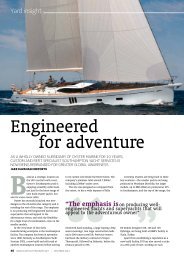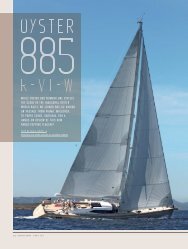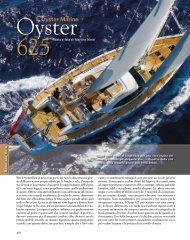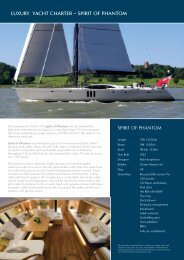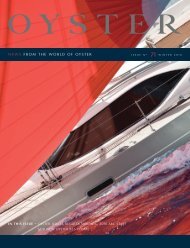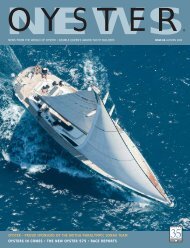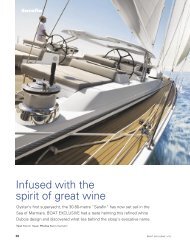You also want an ePaper? Increase the reach of your titles
YUMPU automatically turns print PDFs into web optimized ePapers that Google loves.
Peter Ansell at the helm<br />
“For the first two weeks we<br />
travelled with an albatross,<br />
nicknamed Elle because of<br />
his good-looking legs<br />
which reminded Peter of<br />
the model Elle McPherson”<br />
10 www.oystermarine.com<br />
For the first two weeks we travelled with an albatross, nicknamed Elle because of his<br />
good-looking legs which reminded Peter of the model Elle McPherson. These beautiful<br />
birds can soar the ocean waves for months on end, covering up to 8000 kilometres a<br />
week. There were also a couple of black-backed gulls who kept us company, both called<br />
Jonathan, as we couldn't tell the difference. Apart from these few birds there was no<br />
other sea life, just the large grey waves rolling out to the distant horizons.<br />
During the passage we had been trying to catch fish. There is a lot of ciguatera in the<br />
Pacific islands, which causes numbing in the human nervous system, and we wanted to<br />
stock the freezer from the ocean. We had developed a new fishing system for this year,<br />
involving 400 pound breaking strain line and a good length of bungie to take the strain as<br />
the fish takes off with the lure; too many fish had got away last year with lure, line and<br />
hook and we were determined that this should not continue. There is a small problem<br />
with this system in that the line does not pay out and so there is no noisy rattle to alert us<br />
to a fish on the hook. After a lot of discussion, Chris came up with a brilliant solution and<br />
invented the fog horn fish alarm. Through a series of intricate ‘Heath Robinson’<br />
manoeuvres, a fish on the hook pulls down a lever, thus depressing the trigger on the gas<br />
cylinder, which then lets off a stentorian blast through the fog horn trumpet. This was the<br />
signal for all to rush on deck, reef sails and slow Carelbi down; getting a large fighting<br />
fish six feet up from sea level in the turbulent conditions we were experiencing was not<br />
easy. We were not spectacularly successful, however. The cold waters of the southern<br />
ocean do not seem as well stocked as warmer ones, a couple of fish managed to leap off<br />
the hook before we could gaff them successfully and one just slid off the aft deck<br />
propelled by the violently rolling motion of the boat.<br />
About a week after leaving New Zealand we ran into a major storm lasting<br />
2-3 days, with winds of 45-50 knots, gusting 60 howling through the rigging. Huge<br />
waves, spume blowing off their tops, would lift Carelbi up and slide her down their<br />
backs, pushing her around and slapping her sides with juddering crashes, breaking<br />
over the coach roof and pouring into the cockpit, finally subsiding into sounds of little<br />
rivulets and trickles. Carelbi would stagger, slow, roll and tentatively get under way<br />
again before the whole cycle would repeat itself, endlessly. We hove to the first night to allow<br />
us to get some sleep. The following day one of the rams on the autopilot failed so we handsteered<br />
until we could get to calmer waters, unpack the aft locker and repair the damage.




